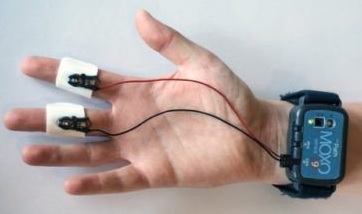
The MOXO wearable was originally developed to study the stress levels of children who have autism. That device, commercialized through MIT professor Rosalind Picard’s startup Empatica, was developed into the E4 wristband that can sense when a seizure is going to occur.
Now, Denver-based mPath is using its sensor to help bring market research insights to companies to help improve their product offerings. The device is designed to pinpoint subconscious responses to different stimulants, like if a consumer gets excited about a certain product or is bored by a performance.
“Right now, companies struggle to understand their customers’ emotional needs or wants,” said CEO Elliot Hedman in a
press release.
So far, the company has worked with brands like The LEGO Company, Best Buy, Google, The Blue Man Group, Lowe’s and Hasbro, as well as government organizations, film companies and hospitals. Now, mPath is launching a project with the Boys and Girls Clubs in Denver to encourage reading.
The technology behind mPath’s MOXO sensor was created by Hedman, Picard and other MIT researchers. The device looks like a bulky smartwatch and wirelessly measures changes in the subtle electrical changes in the skin, or the skin’s conductance. Electrical changes in the skin are an indicator of sympathetic nervous system activity and physiological arousal. If there are spikes in the electrical changes, that can indicate stress and frustration. Dips usually indicate boredom and disinterest.
The startup company is calling its new market research with emotions “emototyping” which combines stress sensors with eye-tracking glasses or GoPro cameras to figure out what a person was looking at during the exact emotions spike or dip. Participants are also interviewed after the experience to see what their opinions are about the data presented from the wearable.
“All of these things combined together in emototyping tell us a deep story about the participant,” said Hedman.
One recent use of the MOXO wearable sensor was used to help a toothpaste company understand peoples’ experiences while brushing their teeth. Researchers from mPath equipped people with the MOXO sensor and a GoPro camera. They measured few to no skin-conductance spikes in the data sometimes and little spikes in data at other times if the user felt inconvenienced. The entire process revealed that people who brush their teeth are looking for a more engaging brushing experience and the toothpaste company is now working to develop products around that research.
MOXO’s technology is also coming into use for helping children read by tracking their eye movement. In some of the tests, they were able to determine that a child that was supposed to be reading was actually looking at posters around the room.
“Our theory is that an entire paragraph can look overwhelming, so we’re developing some ways to make text look more like a poster – something easy to read if they’re trying to learn,” said Hedman.
Hedman hopes that mPath will continue to have an impact on industries and hopes to use it to study student participation in schools and open online courses to help redesign curriculum and classroom experiences.

